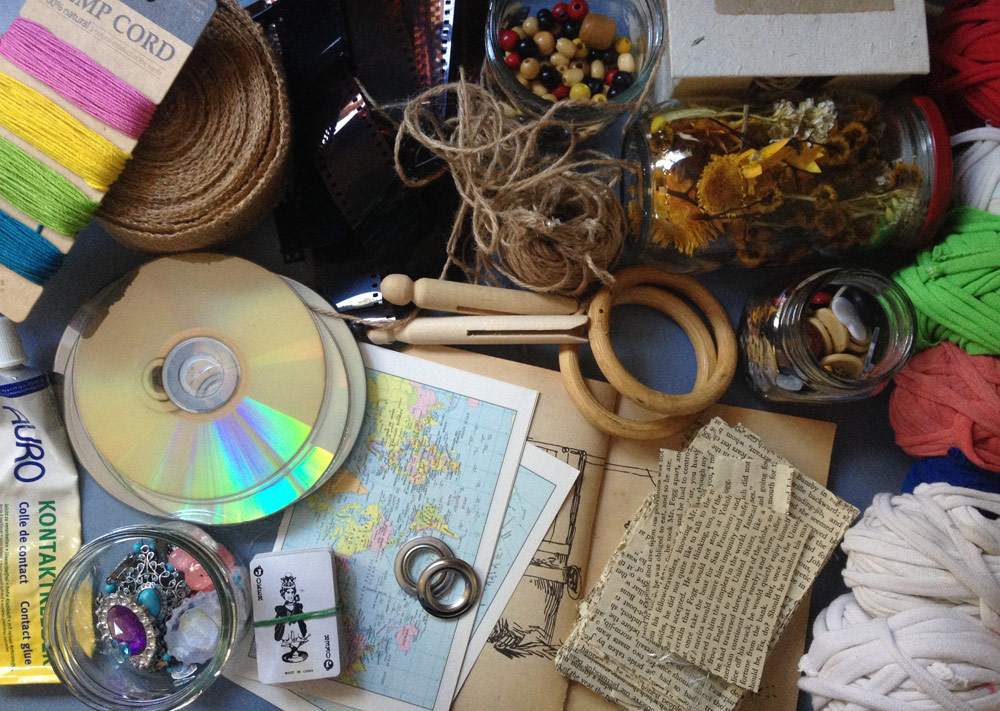Craft Like A Zero Waster, Whatever Your Age

I can become completely absorbed in crafting. I’m not talking about a few hours here and there, I can be lost for weeks in one project after the next as my sense of time disappears. Nothing else matters to the point where I resent the distraction of eating. In fact, it’s been a challenge to step away from my current projects to write this post. If you’ve experienced flow, or something close to it, this won’t seem strange to you.
Psychologist, Mihaly Csikszentmihalyi, first described the phenomenon of complete immersion in an activity as ‘flow’. Flow, Csikszentmihalyi says, is the secret to happiness. Now I’m not an artist and my craft is mostly utilitarian, being home repairs or the creation of something practical to enhance my life, but I do get great pleasure from the problem-solving nature of crafting, the level of mindfulness that can be achieved, and the reward of the end product. The rewards stretch even further for me because I use materials I already have. This saves me money, which I can spend on other joyful things (or working less), and reduces my negative environmental impact through reduced consumption of virgin materials and reduced waste – that makes me feel good too.
Not everyone who crafts will experience flow but other recent studies (all in the beginning stages) suggest that crafting is good for mental health and may even reduce cognitive decline. It seems creativity that takes concentration is a non-medicinal way of getting a feel good high. Children can also benefit from crafting by developing their fine motor and bilateral coordination, self-expression, self-regulation, persistence, imagination, and problem solving skills.
So, what are you waiting for? Start crafting!
How to craft like a zero waster
Crafting involves making things by hand using various fit for purpose materials.
Zero waste living involves diverting as much material as possible from landfill in the process of living our lives.
There are several ways we can obtain materials for craft activities and home repairs which divert waste from landfill. We can:
1. Reuse and repurpose materials already in our possession, no matter what they are made of.
If something in my home can’t be readily rehomed when we’re done with it, I will often deconstruct it into parts for reuse. Clothing, for example, will be disassembled into zippers, cords, clips, hooks, lace, eyelets, buttons, elastic, and ribbons. I store all the parts in boxes and jars so we can easily find them when we need them. This also applies to previous home craft projects or kindergarten and school art projects. I take photos of the special artworks and then pull them apart to reuse the parts. Obviously, you will want to check with your child that their heart won’t be broken if you do this to their work.
2. Reuse and repurpose materials obtained second-hand, no matter what they are made of.
These materials might come from a car boot sale, tip shop, opportunity (thrift) shop, or someone you know. Basically, these materials are at the end of the line and if no one uses them they’ll end up in landfill. There are valuable materials everywhere that could get a lot more use before we discard them. If you take the view that everything is a resource, you will never be without. Waste not, want not.
3. Use materials found in nature like shells, seed pods, leaves, nuts, dried flowers and pebbles.
Both children and adults can benefit from nature play; crafting with materials collected directly from nature is one way to do that. The materials can easily be returned to nature when you are done, without producing any waste.
4. Use new materials that were made from nature like jute, cotton, cellophane, cardboard, metal and glass.
Usually these materials are easily reused, recycled or biodegradable so they don’t need to end up in landfill when you are done with them. Packaging often becomes an issue when we need to buy new supplies. It is hard to avoid single use plastic, but try to find products in packaging made from natural materials, which can be reused, recycled or composted. If you can’t avoid single use plastic packaging, try to recycle it. Soft plastic can be recycled through the REDcycle program and rigid plastic can usually be recycled through Councils’ kerbside collection facilities.
5. Ask ourselves if we really need it and make the most sustainable product choice we can.
I wondered if I could craft and repair items without glue for a long time. After testing this out for a while, I decided that a strong glue was something that could save many other items from being discarded, and was therefore worth having despite there being a small amount of waste. So, I looked for a glue fit for my purposes which was produced with sustainability in mind.
Ideas for materials to include in your craft kit
I love how creative and imaginative children are. My kids have a tendency to look at materials and say “I can turn that into [whatever thing they could play with]”, or they have an idea to build something, and so find ways to complete it with whatever is available. I do the same.
I’ve compiled a list of all the materials currently in our craft kit to give you some ideas. Most of the items have been rescued to be reused as described above.
- Beads – wooden and plastic
- Books – old
- Cardboard boxes, cylinders
- CDs & CD cases
- Cellophane Sheets – real cellophane made from cellulose derived from wood, cotton, hemp or other plant material, not plastic.
- Clips
- Coat hangers made from wire or wood
- Containers
- Cotton twine
- Corks – saved from wine bottles and kindergarten projects
- Fabric offcuts
- Foil trays
- Gift boxes and bags
- Glue – universal contact glue, biodegradable in aluminium tube
- Glue stick – top of sector environmental glue stick
- Haberdashery – buttons, zips, thread, hooks, etc. saved from old clothing
- Hemp cord/twine
- Jars of different sizes
- Jewellery – old and broken
- Jute
- Jute ribbon
- Jute twine
- Lace
- Leather and vinyl pieces
- Maps
- Nature – dried flowers, pebbles, grass for weaving, feathers
- Neoprene – old stubby holders, wetsuits
- Paper – coloured and homemade
- Paper bags
- Perspex
- Photo negatives
- Props and costumes
- Raffia
- Ribbon – saved from old clothing, kindergarten projects, gifts
- Rope
- Sticky tape – biodegradable cellulose tape with biodegradable rubber adhesive
- Tinsel – saved from old Christmas decorations
- Tissue paper – saved from shoe boxes and gifts
- T-shirt yarn – made at home from old t-shirts
- Wire
- Wood offcuts
- Wool or other yarn
- X-rays – used as supports, templates or stencils
Gippsland Unwrapped, Australia

PROFILE
Tammy Logan’s blog about maximising resources and minimising waste.
Learning how to do things differently from the norm of consumerism and convenience has been the most time consuming aspect of pursuing a zero waste lifestyle but also very satisfying. Most things turn out to be very easy once you know what you are doing.
Together I believe we can make a difference and I hope that you will see that a waste free life is about gaining fulfilment, not giving it up.
